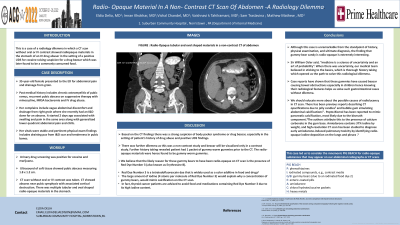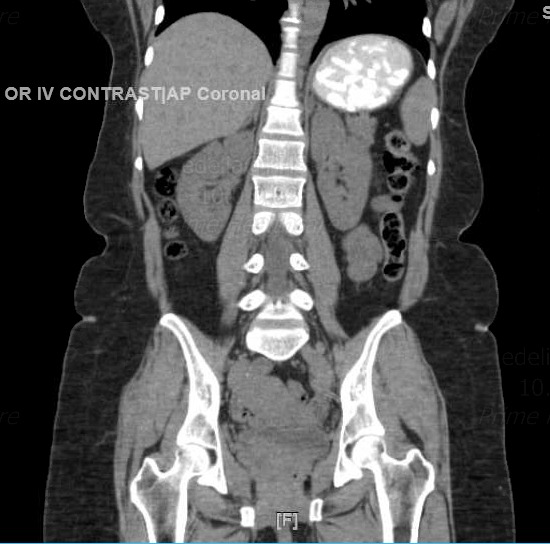Back


Poster Session D - Tuesday Morning
Category: Stomach
D0722 - Radio-Opaque Material in a Non-Contrast CT Scan of Abdomen: A Radiology Dilemma
Tuesday, October 25, 2022
10:00 AM – 12:00 PM ET
Location: Crown Ballroom

Has Audio

Eldia Delia, MD
Suburban Community Hospital
norristown, PA
Presenting Author(s)
Eldia Delia, MD, Imran Khokhar, MD, Vaishnavi k Tahilramani, MD, Sam Traslavina, , Mathew Mathew, MD
Suburban Community Hospital, Norristown, PA
Introduction: This is a case of a radiology dilemma in which a CT scan without oral or IV contrast showed radiopaque materials in the stomach of an IV drug abuser in the setting of a positive UDS for cocaine raising suspicion for a drug bezoar which was later found to be a commonly consumed food.
Case Description/Methods: 35-year-old female with past medical history of chronic osteomyelitis of pubic ramus, recurrent pubic abscess on suppressive therapy with minocycline, MRSA bacteremia, IV drug abuse presented to the emergency department with complaints of vague abdominal discomfort and drainage from right groin where she recently had an I&D done for an abscess. It started 2 days ago associated with swelling and pain in the same area along with generalized lower quadrant abdominal pain and chills. Her vitals were stable and pertinent physical exam findings includes draining pus from I&D scar and tenderness in pubic bones. Urinary drug screening was positive for cocaine and marijuana. Ultrasound of soft tissue showed pubic abscess measuring 1.8 x 1.2 cm. CT scan without oral or IV contrast was taken. CT showed abscess near pubic symphysis with associated cortical destruction. There was multiple tubular and oval shaped radio-opaque materials in the stomach. Based on the CT findings there was a strong suspicion of body packer syndrome or drug bezoar, especially in the setting of patient’s history of drug abuse and positive UDS findings. There was further dilemma as this was a non-contrast study and bezoar will be visualized only in a contrast study. Further history taking revealed patient had 1 packet of gummy worm gummies prior to the CT. The radio-opaque materials were hence found to be gummy worm gummies.
Discussion: Through literature review it was found that gummy bear gummies have Red Dye Number 3, also known as Erythrosine B. This dye is a tetraiodofluorescein dye which has 4 atoms of iodine per molecule of dye and is widely used as a coloring agent in food and drugs. In fact, this is the reason why thyroid patients are advised to avoid this food. Sir William Osler said “medicine is a science of uncertainty and an art of probability”. When there was uncertainty, our medical team believed in sticking to the basics, which is thorough history taking which opened us the path to solve this dilemma. Case reports have shown that these gummies have caused bezoar causing bowel obstructions especially in children hence knowing their radiological features helps us solve such gastrointestinal cases without dilemma.

Disclosures:
Eldia Delia, MD, Imran Khokhar, MD, Vaishnavi k Tahilramani, MD, Sam Traslavina, , Mathew Mathew, MD. D0722 - Radio-Opaque Material in a Non-Contrast CT Scan of Abdomen: A Radiology Dilemma, ACG 2022 Annual Scientific Meeting Abstracts. Charlotte, NC: American College of Gastroenterology.
Suburban Community Hospital, Norristown, PA
Introduction: This is a case of a radiology dilemma in which a CT scan without oral or IV contrast showed radiopaque materials in the stomach of an IV drug abuser in the setting of a positive UDS for cocaine raising suspicion for a drug bezoar which was later found to be a commonly consumed food.
Case Description/Methods: 35-year-old female with past medical history of chronic osteomyelitis of pubic ramus, recurrent pubic abscess on suppressive therapy with minocycline, MRSA bacteremia, IV drug abuse presented to the emergency department with complaints of vague abdominal discomfort and drainage from right groin where she recently had an I&D done for an abscess. It started 2 days ago associated with swelling and pain in the same area along with generalized lower quadrant abdominal pain and chills. Her vitals were stable and pertinent physical exam findings includes draining pus from I&D scar and tenderness in pubic bones. Urinary drug screening was positive for cocaine and marijuana. Ultrasound of soft tissue showed pubic abscess measuring 1.8 x 1.2 cm. CT scan without oral or IV contrast was taken. CT showed abscess near pubic symphysis with associated cortical destruction. There was multiple tubular and oval shaped radio-opaque materials in the stomach. Based on the CT findings there was a strong suspicion of body packer syndrome or drug bezoar, especially in the setting of patient’s history of drug abuse and positive UDS findings. There was further dilemma as this was a non-contrast study and bezoar will be visualized only in a contrast study. Further history taking revealed patient had 1 packet of gummy worm gummies prior to the CT. The radio-opaque materials were hence found to be gummy worm gummies.
Discussion: Through literature review it was found that gummy bear gummies have Red Dye Number 3, also known as Erythrosine B. This dye is a tetraiodofluorescein dye which has 4 atoms of iodine per molecule of dye and is widely used as a coloring agent in food and drugs. In fact, this is the reason why thyroid patients are advised to avoid this food. Sir William Osler said “medicine is a science of uncertainty and an art of probability”. When there was uncertainty, our medical team believed in sticking to the basics, which is thorough history taking which opened us the path to solve this dilemma. Case reports have shown that these gummies have caused bezoar causing bowel obstructions especially in children hence knowing their radiological features helps us solve such gastrointestinal cases without dilemma.

Figure: Radio-Opaque tubular and oval shaped materials in a non-contrast CT of abdomen.
Disclosures:
Eldia Delia indicated no relevant financial relationships.
Imran Khokhar indicated no relevant financial relationships.
Vaishnavi k Tahilramani indicated no relevant financial relationships.
Sam Traslavina indicated no relevant financial relationships.
Mathew Mathew indicated no relevant financial relationships.
Eldia Delia, MD, Imran Khokhar, MD, Vaishnavi k Tahilramani, MD, Sam Traslavina, , Mathew Mathew, MD. D0722 - Radio-Opaque Material in a Non-Contrast CT Scan of Abdomen: A Radiology Dilemma, ACG 2022 Annual Scientific Meeting Abstracts. Charlotte, NC: American College of Gastroenterology.
